In January 1970, master Toho
Company Ltd. Special effects genius, Eiji Tsuburaya, passed away from heart
failure at age 69. Effects artist Sadmasa Arikawa was then elevated to head
of the special effects department and his first assignment was this 1970 effort.
While not as good as some of the classic films produced during Toho's heyday
of 1955 to 1968, it still has a somewhat special place in the hearts of genre
fans, especially fans of the American version released in 1971 by American International
Pictures (under the title YOG: MONSTER FROM SPACE) on a spectacular double-bill
with THE ABOMINABLE DR. PHIBES. Now, this film makes its long-awaited American
DVD debut from Media Blasters as part of their long line of Toho releases (THE
MYSTERIANS, VARAN THE UNBELIEVABLE, MATANGO, DOGORA, ATRAGON).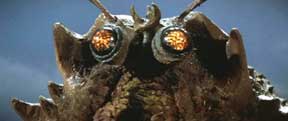
A real estate developer (Yu Fujiki) plans to construct a resort hotel on the Pacific island of Selgio. He sends his assistant (Atsuko Kobayashi), a photographer (Akira Kubo), and a scientist (Yoshio Tsuchiya) to scout the island and make final plans for development. This group is followed to the island by Makota Obata (Kenji Sahara in a well-acted villainous role), a rival real estate developer. At the same time, an unmanned rocket is taken over by a strange glowing substance and sent back to Earth. After crashing near Selgio Island, the substance begins taking over marine life (a squid, a crab and a turtle) causing them to grow to gigantic proportions and attack the inhabitants of the island. It seems this alien life-form has come to Earth with the specific intent of taking over the planet by creating uncontrollable giant monsters and possessing humans and making them subservient to the alien’s will.
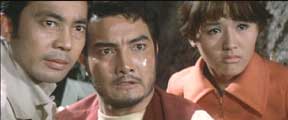 SPACE
AMOEBA is arguably the last of the classic Toho giant monster movies. The film
was the last to combine the artistic talents of director Ishiro Honda, producer
Tomoyuki Tanaka with a musical score by Akira Ifukubie until they teamed up
again for one final monster bash in 1975’s TERROR OF MECHAGODZILA. From
1971 though 1974, other directors (Yoshimitu Banno for GODZILLA VS. THE SMOG
MONSTER, and Jun Fukada for GODZILLA VS. GIGAN, GODZILLA VS. MEGALLON and GODZILLA
VS. MECHAGODZILLA), helmed the remainder of the Godzilla series and with combined
reduced budgets and relatively no-name casts, there appeared a noticeable decrease
in quality.
SPACE
AMOEBA is arguably the last of the classic Toho giant monster movies. The film
was the last to combine the artistic talents of director Ishiro Honda, producer
Tomoyuki Tanaka with a musical score by Akira Ifukubie until they teamed up
again for one final monster bash in 1975’s TERROR OF MECHAGODZILA. From
1971 though 1974, other directors (Yoshimitu Banno for GODZILLA VS. THE SMOG
MONSTER, and Jun Fukada for GODZILLA VS. GIGAN, GODZILLA VS. MEGALLON and GODZILLA
VS. MECHAGODZILLA), helmed the remainder of the Godzilla series and with combined
reduced budgets and relatively no-name casts, there appeared a noticeable decrease
in quality.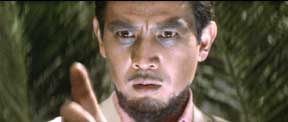
The cast of SPACE AMOEBA is chock-full of veteran Toho monster film talent. Akira Kubo as the photographer Kudo also appeared in GORATH (1962), ATTACK OF THE MUSHROOM PEOPLE (1963), MONSTER ZERO (1965), SON OF GODZILLA (1967) and DESTROY ALL MONSTERS (1968). Playing the scientist, Yoshio Tsuchiya had stand-out roles as aliens in THE MYSTERIANS (1957) and as “The Controller of Planet X” in MONSTER ZERO as well as scientists in SON OF GODZILLA and DESTROY ALL MONSTERS. Yu Fujiki as the real estate developer also appeared in KING KONG VS. GODZILLA (1962) and ATRAGON (1963) and Kenji Sahara as Obata appeared in RODAN (1956), THE MYSTERIANS, THE H-MAN (1958), KING KONG VS. GODZILLA, GODZILLA VS. THE THING (1964), GHIDRAH (1965), SON OF GODZILLA, DESTROY ALL MONSTERS, WAR OF THE GARGANTUAS (1966) and GODZILLA’S REVENGE (1969).
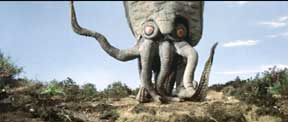 Although
the monsters of SPACE AMOEBA may not be up to the caliber of creatures created
by Eiji Tsuburaya during the boom years, they do generate a fair amount of thrills
throughout the film. This is most especially true of Gezora, the giant squid
which has become something of a fan favorite over the years and it even made
an appearance on Nintendo’s Godzilla video game from the early 1990s.
Although
the monsters of SPACE AMOEBA may not be up to the caliber of creatures created
by Eiji Tsuburaya during the boom years, they do generate a fair amount of thrills
throughout the film. This is most especially true of Gezora, the giant squid
which has become something of a fan favorite over the years and it even made
an appearance on Nintendo’s Godzilla video game from the early 1990s.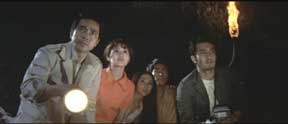
This Media Blasters presentation is yet another visual treat in keeping with their other Toho releases of 2004/2005. It is presented anamorphic in its original Tohoscope (2.35:1) ratio, with a magnificently clear and sharp picture and vivid colors. Like Media Blasters’ DVD of ATRAGON, the underwater scenes in which Gezora attacks a diving party are much clearer and detailed than they were in Toho’s laserdisc release from the 1990s. The Media Blasters DVD is apparently taken from the same source as Toho’s Japanese DVD. The audio (impressive on all counts) is presented in Japanese (2.0 and 5.1) and English (2.0 and 5.1) with optional subtitles for the Japanese language version. Extras include an audio commentary with co-producer Fumio Tanaka and the original 1970 Japanese theatrical trailer and teaser trailer. In addition, there is a trailer gallery of other Tokyo Shock Toho titles as well as a brief but amusing mini-documentary detailing the real life biological structure of the squid, turtle and crab, comparing them with the monstrosities seen in the film.
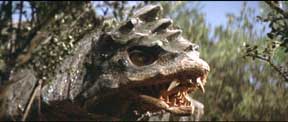 One
item of note, however, about the dubbed version presented on this DVD: it is
NOT the same dubbed track done in 1971 by AIP and Titan Sound Corporation (formerly
Titra Sound Studio) in New York. As was the case with Media Blasters’
recent release of ATRAGON, the English audio track presented on this DVD is
the “international version” done by Toho in Hong Kong. Die-hard
genre fans will immediately recognize the voice artists later used in GODZILLA
VS. HEDORAH (the international version of GODZILLA VS. THE SMOG MONSTER), GODZILLA
VS. GIGAN and GODZILLA VS. MEGALLON.
One
item of note, however, about the dubbed version presented on this DVD: it is
NOT the same dubbed track done in 1971 by AIP and Titan Sound Corporation (formerly
Titra Sound Studio) in New York. As was the case with Media Blasters’
recent release of ATRAGON, the English audio track presented on this DVD is
the “international version” done by Toho in Hong Kong. Die-hard
genre fans will immediately recognize the voice artists later used in GODZILLA
VS. HEDORAH (the international version of GODZILLA VS. THE SMOG MONSTER), GODZILLA
VS. GIGAN and GODZILLA VS. MEGALLON.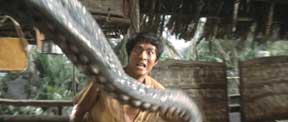
On a brief and sad item of note: while this reviewer was composing this article, the news broke in Japan and around the world that composer Akira Ifukube passed away at age 91. With Mr. Ifukubie’s passing, the last of the creative team of the original 1954 GOJIRA (Ishiro Honda, Eiji Tsuburaya, Tomoyuki Tanaka and Akira Ifukube) is gone, but he left an enormous mark in the cinema as so many science fiction composers have acknowledged the impact that Ifukubie-san has had on them. In addition to creating the haunting score for GOJIRA, he also created the monster’s distinctive roar. He will be badly missed, but fondly remembered and this review is dedicated to his memory.
Even though the familiar AIP dubbing is missing from this DVD, it is actually a very small price to pay in an otherwise excellent presentation. Genre fans should give Media Blasters a well-deserved round of applause for preserving the integrity of these Toho classics and allowing fans to see and enjoy them the way they were intended by their producers to be viewed. (Joe Cascio)